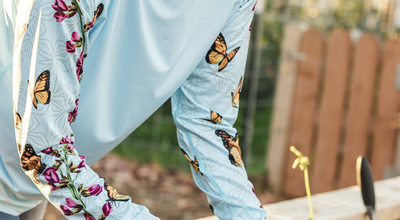How to Grow all-year-round, Indoors
If you have you're feeling down about going into the off-season, you're not alone. The skies are getting gray and the garden bed are likely looking a little empty. It's not too late to yield some produce for winter if you're able to bring things indoors.
Many of your backyards might look a little like our friends Marv and Char’s from @plantedinthegarden. This green-thumbed duo took us on a tour of their flourishing indoor winter garden, where Marv dug up and dished out what’s been growing for him, telling us everything you’ll need to make it happen yourself.

Check out his setup in our featured IG Reel. He even threw in some tips on what’ll thrive all season long.
If Marv makes it look easy, that’s because he’s a well-seasoned gardener—and it totally can be with the right supplies. Here’s his breakdown of what you’ll need:
Where does it Grow?
Shelving Units
They’re using 2’ x 8’ metal for shelves—a good investment for continuous wear and easy to clean.
Marv recommends two shelves for the taller plants and several for the seedlings and micro-greens.
Containers
This is where it gets dirty, or not dirty at all. Marv’s got a mix of hydroponics and soil going on here.

What You’ll Need for Hydroponics
They’re using DIY containers with air pumps, which reduce the water change and allow more oxygen to maximize nutrient uptake (you can see how he does it here—link).
They also use the Kratky method for other containers, requiring no air pump. You’ll need liquid nutrients for both methods of feeding the plants.
For Soil: It’s Simple
Marv suggests indoor potting soil with an inch of sand layer on top to ward off pesky fungus gnats. These will also require slow-release fertilizers.
While there’re certainly some differences between soil and hydroponics, the big one is that there won’t be many bugs when growing hydroponically.
Now, Let’s Shed Some Light on the Rest of the Operation
LIGHT!
Marv is choosing grow lights over window lighting for the sake of consistency and control.
Okay, we see the light, but what kind? And for how long?
Marv’s got two types going on here:
Bright lights, used to cover the whole space, are set somewhere between 2 to 3 feet above the plants. These lights are running for 10 hours.
If there’s no sign of leaf burning or lanky growth, there’s no need to adjust the lights during the growth stage.
Low lights are up close, between 3 and 5 inches, running for 14 hours.
And for adjustments: lower the light if the plants are lanky and raise it if leaf burn is present.
For all lighting, times can vary, so Marv recommends using a timer to stay shining anywhere from 8 to 16 hours.
And Then, There’s Everything Else
Fan? This helps in multiple ways: circulation prevents dampness (not the kind of dank we’re interested in) and assists in pollination.
Note: a small fan will do—sometimes, there can be too much of a good thing.
Pollination, you ask? If it can’t be done through the air, it must be done by hand. For hand pollination, gently tap the flowers to pull the pollen. For plants that produce male and female flowers, use a brush to transfer pollen.
Heat? No need. Everything should be good to go with a stable room temperature and heat immitted from the lights.
Note: if you’re growing indoors through those hot summer months, some type of cooling system might be necessary, depending on your local climate.

Planting Pro-Tips:
Growing From Seeds
Marv recommends succession planting. This process allows for continual harvest—one of the more fruitful perks of home gardening.
If this planting process sounds appealing to you, it’ll be necessary to get a seed station going for sprouts.
Maximizing Grow Space
Beyond the shelves, there’s still plenty of light for other things to grow. This is a great place to grow bigger potted plants, like citrus trees, or bring in some of those plants from outside that don’t handle the cold during the winter months.
The Produce that Keeps on Producing
Marv recommends growing Swiss chard, bok choy, mizuna, lettuce, and celery (to name a few multiple harvest varieties). You can pluck the greens you need for dinner and come back to harvest again and again.
Now, The Fruits of Your Labor
Our friends at @plantedinthegarden break it down in a systematic yet straightforward way. For many, indoor growing can seem like a somewhat daunting newer science reserved for expert growers. Char and Marv let us see there isn’t much more to it. After seeing how streamlined their indoor setup is, the variables of growing back outdoors seem a little sketchy. Environmental control is a huge advantage, not to mention the bonus of having seeds grown into plants ready to plant outside when the timing is right.

And while these guys show us their fully-loaded operation with 2 feet by 8 feet shelving and eight containers holding 70-plus plants, you can do your own, bigger or smaller, following the same principles on a different scale.
We’re sending a huge shoutout and thanks to our friends @plantedinthegarden. They’ve dropped some invaluable knowledge on us to share with you. Now the fruits of their labor can be yours too.












